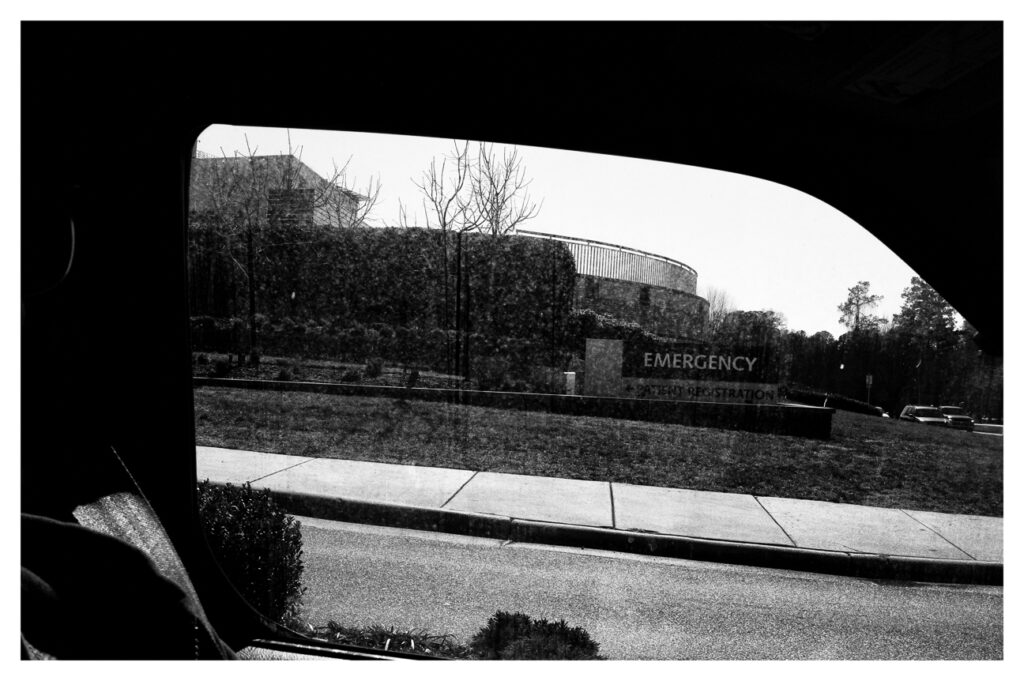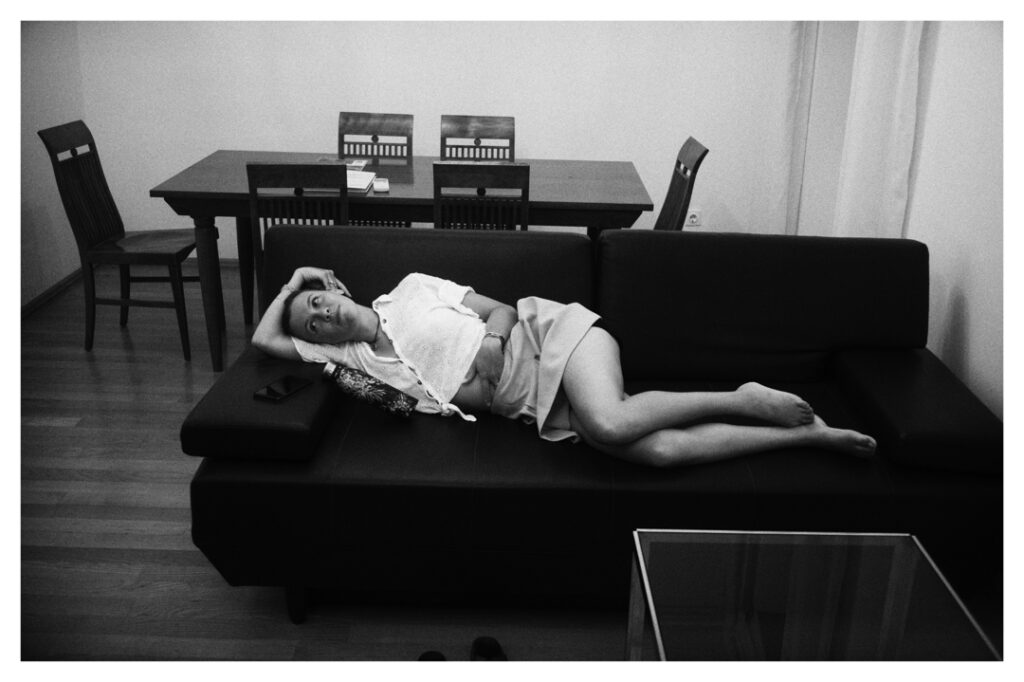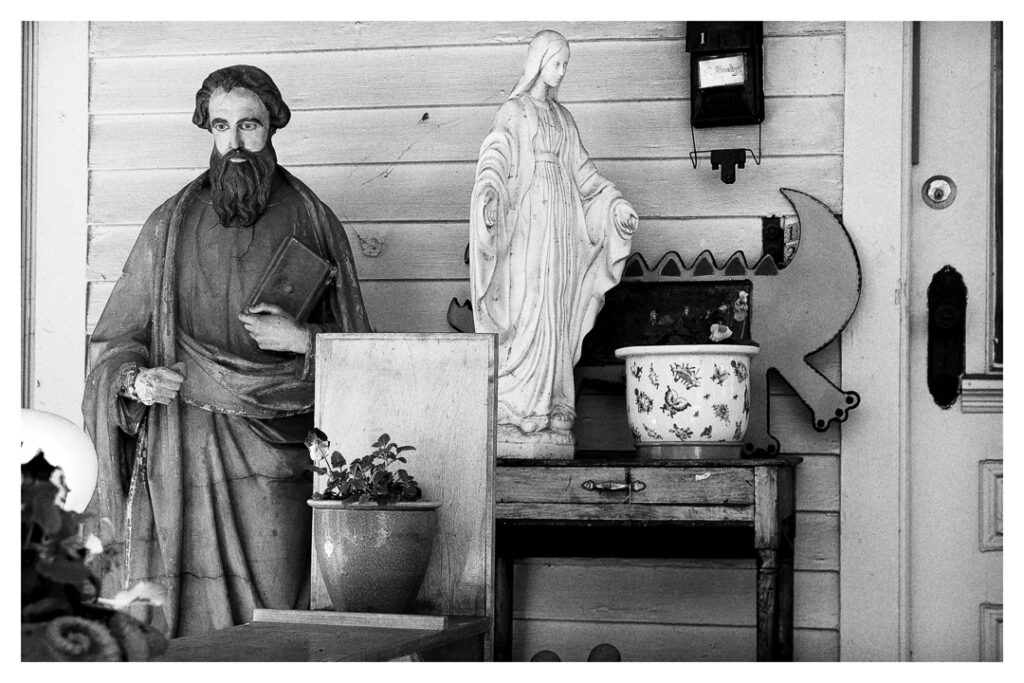In 2012, Leica introduced the M9 Monochrom, a dedicated monochrome (B&W) camera, the first digital black and white camera in 35mm format. According to Leica, the Monochrom “builds on the rich tradition of analog black and white photography and brings authentic monochrome photography into the digital era.” With a full native resolution of 18 megapixels, the Monochrom easily bested similar megapixel color sensors; unlike Bayer sensors, the Monchrom sensor records the true luminance value of each pixel, delivering a “true” black and white image straight from the sensor. In addition, users could apply characteristic analog toning effects like sepia, cold or selenium toning directly from the camera; just save the image as a JPEG and select the desired toning effect, “no need for post-processing.”

Of course, few Monochrom owners are going to shoot jpegs. Most are going to shoot RAW files and post-process, and to that end, Leica gave original owners a free copy of Silver Efex when they purchased the camera: ” Purchase includes a plug-in version of Nik Silver Efex Pro™ software, considered to be the most powerful tool for the creation of high-quality digital black and white images. For pictures that perfectly replicate the look of analog exposures, Siver Efex Pro™ offers selective control of tonal values and contrast and an extensive collection of profiles for the simulation of black and white film types, grain structures, and much more.”
Which leads me to note the contradiction. Invariably, Leica users champion the uncompromising standards of the optics, while often simultaneously dumbing down their files post-production to give the look of a vintage Summarit and Tri-X pushed to 1600 ISO. As noted above, Leica themselves seem to have fallen for the confusion as well. They’ve marketed the MM (Monochrom) as an unsurpassed tool to produce the subtle tonal gradations of the best B&W, but then bundle it with Silver Efex Pro software to encourage users to recreate the grainy, contrasty look of 35mm Tri-X.
*************

Clearly, Leica claimed and marketed the Monochrom, not merely as a black and white digital camera but as a digital camera that could accurately recreate the black and white film aesthetic. The distinction may be fine, but it’s a distinction just the same, and I think it gets to the heart of what I see as a misconception about the Monochrom’s actual output. Don’t get me wrong: the Monochrom delivers stunning black and white files, super clean past 800 ISO, beautifully subtle tones, file sharpness rivaling Bayer sensors with twice the resolution. It’s just that its files don’t look like film capture, and as I’ve noted in previous posts about my Digital Tri-X solution, it doesn’t particularly take to Silver Efex emulations, where a cheap D200 or a 4 mp Sigma SD15 Foveon best it for emulating the film look.


Here’s a Monochrom file processed in Lightroom without further film emulation:

Here’s the same file run thru the Silver Efex Tri-X emulation:

Here’s a Nikon D200 10 MP RAW file run through the Silver Efex Tri-X Emulation:

Finally, here’s a 14MP (actually 4.6mp when calculated in the Bayer manner) Sigma Foveon file from an SD15 run through the Silver Efex Tri-X emulation:

Now, acknowledging that aesthetic preferences are precisely that, preferences, my analysis is as follows: 1) The straight Monochrom file is nice for what it is – a digital B&W photo. It avoids that plastic look too often seen with digital B&W files and it has a nice graduated tonality. 2) The Tri-X Monochrom file is nice, but it doesn’t look like Tri-X. Too sharp, not enough grain structure evident. 3) The D200 and the Sigma Sd15 files are digital Tri-X, although the D200 benefits just a bit from less sharp optics; the Sigma file, even though <5mp, shows a sharpness and depth I doubt you’d get on a classic Tri-X shot with a 35mm Summicron. Sharper optics, sharp sensor.
*************

So, the question becomes, is the Monochrom worth it i.e. do we need a dedicated digital B&W sensor if our goal is, as per Leica ad copy ” to have a tool that combines state-of-the-art […] digital technologies to deliver black-and-white images of incomparable quality”? It certainly doesn’t hurt, but probably not. Don’t get me wrong: I love the idea of the Monchrom and its output can be stunning when done correctly. And it feels and performs like a Leica M, which is no mean feat. It’s definitely a fascinating camera and I applaud Leica for sticking their collective necks out and producing them.
But if you’re buying it to give you a leg up on recreating the B&W film look of your photographic youth, you may want to look at much more cost effective solutions I’ve noted elsewhere. It’s not something that you can’t also do with a regular Bayer sensored digital camera if you take your time. The key seems to be using a Bayer CCD sensor in the 10-12 MP range like that found in the Nikon D200 or the Fuji S3 Pro. Other alternatives are the DP1/2/3, SD14 or SD15 Foveons whose functional MP counts are somewhere around 10MP as well. It seems that 10MP is the sweet spot for both taking advantage of Silver Efexs’ simulated Tri-X grain structure and giving a resolution look similar to that you used to get with you M4, Summicron and Tri-X shot at box speed. A CCD sensor seems to help too.
You can put together a D200 with a AF 24mm Nikkor or older Nikkor Zoom of your choice for $200. An SD15 is going to run you $550 with a really fine Sigma optic like the 24mm EX DG. A twelve year old CCD Monchrom is going to run you $3500-$4000. Is it worth the price differential? That’s not a question to ask Leicaphiles, as, with Veblen Goods, you don’t buy on price but rather other intangibles. But, for all its cache, you don’t need a Monchrom if you aspire to, in Leica’s words, “to transform analog black and white into digital.” A ratty old D200 or Fuji S3 PRO will do just fine.


Tonal range, detail and pliability. That’s what I think of when thinking of a Monochrom camera.
The dedicated mono sensor used “correctly” isn’t the end, but the means in my opinion. The biggest advantage other than a slight tonal range gain is somewhat the same as a Foveon…more fine detail per MP and if done right, something a Foveon has trouble with: a very tweakable, much better high ISO file to work on in Lightroom.
But would I ever shoot the Monochrom for its pure Mono output? No. It’s not as forgiving as HP5, Tri-X or my gobs of expired BW400CN especially in highlights. And no, not even DxO FilmPack 6 or Silver or anything else does it exactly right…DxO is pretty close on BW400CN tho from practice (not Tri-X tho). I’ve almost traded my M240 for a Monochrom, and I really wish I could just plop down the cash to purchase yours, TBH, but with Foveon, Sony A100 (same sensor as the D200 methinks) and the Cobalt Imaging CCD Monochrom profile for the Sony’s (A100, A99) and the M240, I get something almost as nice as what I’ve seen done with the M9 Mono…like 90-95% of the Mono.
The Foveon is the closest I’ve ever gotten to a digital file that just comes out of camera like I like it…and it’s not film and it’s not bayer digital…it’s unique and juicy, hahah.
But I say all this and still want the M9 Mono in my toolbelt, but that’s just because I’m smitten with the idea of reduction of futzing and my M240 just has a few too many levels of that.
I should probably just shoot film more, but I’m super lazy about processing my film.
And I really have to thank you for your insight on how good the JPG’s are for BW. I’ve shot Foveon since the original DP1 but for some reason didn’t ever shoot JPG, probably because the reviews always said how bad the (color) ones were. I just shot a self-portrait at ISO 1000 and damn, even the noise looks really good. I dropped it into DxO FilmPack 6 and compared adding grain only sims, but actually prefer the default look of the JPG.
It’s kind of refreshing to just shoot JPG and “be done”…thank you, sir!
Glad i could help. Yes, the jpegs out of the SDQ for B&W rock.
Oh, and Tim, write times shooting JPG only are much much faster as you probably know. On my DP2M it’s about 19 sec for RAW, or RAW+JPG, but JPG only is about 8 sec. Scary to just shoot JPG, but love the quicker write times!
Thank you for teaching an old Foveon user new tricks 🙂
Well, happy to have helped, Patrick. if I taught you something it was just blind luck on my part. While I used to own a DP2 Merrill I only shot X3F files with it and yes, it was slow. It was only when I bought the sd Quattro that I discovered the jpegs to be so good, and that I just stumbled upon. I’m nor sure the older, pre-Merrill Foveons like the SD15 take well to jpegs, or at least that’s what I’ve been told.
I can’t/won’t drop the dough on Leica, and unless a miracle happens and my mojo comes back to say hello, it’s now very unlikely I’ll ever buy any camera again. We had yachtie friends: the husband, in his late years, bought a brand-new Mercedes 500 SL and went from his hot 82ft Italian power cruiser to a motor sailer up in the 90-something ft range. He wanted to sail in the Amazon area. He never made it: he just died a year or so later instead. His wife got rid of the car asap, and her own declining health meant she could no longer go from dinghy, up gangway, onto boat. It had to go. She also followed her late mate pdq. So it goes; big spends make sense in youth, when you can afford to do them, if you can afford to do them.
I used film all my working life, came to the technical conclusions that worked for me, and then just got on with it as best I could.
Film always cost money, had to be budgeted along with everything else. The place where present-day digital technology would have been useful was for doing model tests: looking back, I can think of several girls who might have proved better than I’d originally imagined had I been willing to spend more of my own time and materials on them. I wasn’t, so potential was never fully explored, neither for them nor for me.
For a while, I automatically went on to add some noise to many of my non-commercial website images; I think that I did it hoping to add interest, accentuate, perhaps, the generally dark sense to much of that personal work. I’m not sure why I have gravitated towards the visual gloom, but find it impossible to believe in bright, sunny imagery anymore. It could well be the result of deep losses in life, perhaps not; maybe it’s a tendency towards attempting to highlight something within a broader frame… it just feels my natural way. In the end, the single most difficult thing to achieve in photography isn’t so much look as finding truly worthwhile subject. There is always, too, the reality that chasing look can sometimes be nothing more than a means to avoiding that truth. I’ve employed that device quite often; it fills me with no lasting joy, even if a passing satisfaction when I prove to myself that technically, I still can.